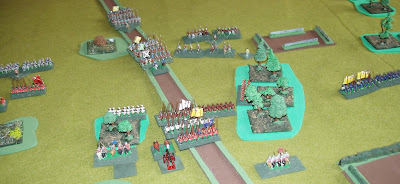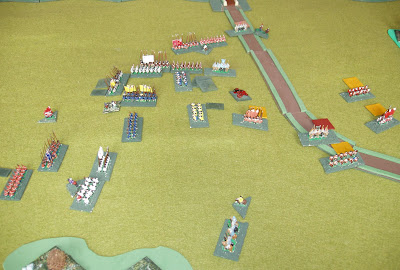The twelfth move of the War of Stuart Succession saw, well, quite a lot happening. If you recall, James VI of Scotland had been forced to withdraw north after his defeat in the North Riding of Yorkshire. As his GOOS roll was now lower than it was before, he failed it, and the Durham trained bands, who had been quiet on the march south, decided to ambush him. At least, it was supposed to be an ambush, but read on.
In the north-west, James’ second army has crossed the border with England, and the Cumberland trained bands have rallied against them. Given everything else going on, I decided to fight this wargame after James in Durham. It could end up a bit Solway Moss...
In the south, the Dutch, in a sudden burst of activity, launched their new fleet into Thames region. Arbella Stuart decided to raise another army, hers now being under the command of her supposed paramour, Edward Seymour. Edward Seymour, on the other hand, fumbled his initiative roll again and landed up with a mutiny. The army hitherto raised and led by Arbella clearly did not find his generalship to its taste, and they went home, leaving both Edward’s and Arbella’s GOOS scores lowered. Isabella, on the other hand, made her initiative roll and got a military move. Two options were open, either to move against the Dutch in the Channel or to intervene in Buckinghamshire.
It really did not take long for Isabella to decide. Her London-based army moved into Buckinghamshire and took both Arbella and Edward into protective custody, before Arbella could rally a new army. It really has not been Edward Seymour’s campaign.
Anyway, with ambush in my mind, I rolled up a fairly dense terrain for the Durham men to entertain the Scottish king. I hesitated a bit over the Scottish strength, initially deducting the three bases they had lost in Yorkshire. After all, they are on the retreat and need to brush the trained bands aside rather than fight an all-out battle. In the end, I decided that this was a bit mean on the Scots, and the three bases were restored, but at the end on the army, assuming that they were straggling a bit.
The English are on the left in the shot above. The nearest foot are on a hill, and the ones at the far side are also on the end of a ridge, which you can just make out if you look carefully. The Scots musketeers in front of them are further along the same ridge. The bulk of the trained bands are on the road between the woods, having attempted to set an ambush for the Scots. Musketeers are in the woods, and the pike are two deep, with another in reserve.
James decided that only an assault of extreme violence would redeem his position and his reputation. He is therefore leading the three deep pike on the road, the plan being that the light horse next to him will deal with the English borderers. The pike will advance rapidly and attack the centre of the English position while the demi-lancers charge anyone who might get in the way. It was perhaps a high-risk plan, but as someone on our own timeline said of James, ‘Desperate diseases require desperate remedies.’
The photograph above shows the Scottish plan unfurling from behind English lines. On the left, the Scottish musketeers are giving their English counterparts a bit of a pummelling. In the centre, the Scottish light horse have forced their English counterparts to retreat, shaken (they are lurking behind the smaller wood). The pike, under the leadership of their king, are storming up the road, with the stragglers behind, and the lancers are coming into position. The Scottish light horse will, next move, head across the board to engage the English right wing. So far, so good.
The above shows, as it were, the big crunch. The Scottish light horse have moved across, as advertised. On the English left honours are about even, with the English pike dealing with one of the Scottish bases, but the other have the edge over the English shot. In the centre, James and his pike have hit the English, which the general has just managed to close up with the reserve. The only downside on the Scottish side is that, for reasons best known to themselves, the Scottish demi-lancers have refused to charge home. The English musketry from ambush, incidentally, had no impact whatsoever.
As is my standard practice, I was using a blue D6 for the Scots, and a red one for the English. The pike combat roll was made, and a neck was craned to see the result.
My head was held in some despair for the Scots before I even started to calculate the combat outcome. I mean, what a time to roll a 6-1. Ouch.
The outcome could have been worse, I suppose. The Scots recoiled shaken and the English, of course, followed up. However, it also meant that James had to roll for risk to his person, being the general in a losing close combat. Fine, on a 1-4 roll, he would be unscathed. The dice decided this was an excellent opportunity to roll a 6. General down.
The result felt kind of inevitable from then on. While the Scots kept the initiative, the pike did not survive the next round of combat, especially as the English had the tempo to advance their flanking musketeers as well. The rout of the foremost Scottish pike swept away their reserves as well, as seen above. On the ridge, the English pike have routed their foes, while the Scots have the English shot at a disadvantage.
The slight advantage of the Scots on their right was to no avail, however. Seven bases and a general down left them with a -4 army morale, which did not improve on the dice roll, and so the army routed.
So far this turn, then, Isabella now controls two of the three other claimants to the throne, and the fate of James VI is unknown at present. It is quite possible he has followed his great-grandfather James IV and gone down fighting at the head of his pike while invading England. We shall see...














